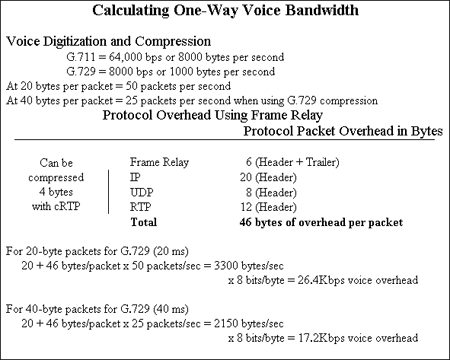VoIP bandwidth: Calculate consumption
The bandwidth needed for VoIP transmission depends on compression technology, packet overhead and the network protocol used. In this tip, learn how to calculate how much bandwidth your VoIP implementation will need.
The bandwidth needed for VoIP transmission will depend on a few factors: the compression technology, packet overhead, network protocol used and whether silence suppression is used. This tip investigates the first three considerations. Silence suppression will be covered in a later tip.
VoIP bandwidth resources
What's in a VoIP packet -- An introduction to bandwidth for VoIP
How voice compression saves bandwidth
VoIP bandwidth -- Rightsize your WAN for voice traffic
There are two primary strategies for improving IP network performance for voice: Allocate more VoIP bandwidth (reduce utilization) or implement QoS.
How much bandwidth to allocate depends on:
- Packet size for voice (10 to 320 bytes of digital voice)
- CODEC and compression technique (G.711, G.729, G.723.1, G.722, proprietary)
- Header compression (RTP + UDP + IP), which is optional
- Layer 2 protocols, such as point-to-point protocol (PPP), Frame Relay and Ethernet
- Silence suppression/voice activity detection
Calculating the bandwidth for a VoIP call is not difficult once you know the method and the factors to include. The chart below, "Calculating one-way voice bandwidth," demonstrates the overhead calculation for 20 and 40 byte compressed voice (G.729) being transmitted over a Frame Relay WAN connection. Twenty bytes of G.729 compressed voice is equal to 20 ms of a word. Forty bytes of G.729 compressed voice is equal to 40 ms of a word.

The results of this method of calculation are contained in the next table, "Packet voice transmission requirements." The table demonstrates these points:
- Bandwidth requirements reduce with compression, G.711 vs. G.729.
- Bandwidth requirements reduce when longer packets are used, thereby reducing overhead.
- Even though the voice compression is an 8 to 1 ratio, the bandwidth reduction is about 3 or 4 to 1. The overhead negates some of the voice compression bandwidth savings.
- Compressing the RTP, UDP and IP headers (cRTP) is most valuable when the packet also carries compressed voice.
| Packet voice transmission requirements (Bits per second per voice channel) |
|||||||||||
| Codec | Voice bit rate | Sample time | Voice payload | Packets per second | Ethernet |
|
|||||
| G.711 | 64 Kbps | 20 msec | 160 bytes | 50 | 87.2 Kbps | 82.4 Kbps | 68.0 Kbps | ||||
| G.711 | 64 Kbps | 30 msec | 240 bytes | 33.3 | 79.4 Kbps | 76.2 Kbps | 66.6 Kbps | ||||
| G.711 | 64 Kbps | 40 msec | 320 bytes | 25 | 75.6 Kbps | 73.2 Kbps | 66.0 Kbps | ||||
| G.729A | 8 Kbps | 20 msec | 20 bytes | 50 | 31.2 Kbps | 26.4 Kbps | 12.0 Kbps | ||||
| G.729A | 8 Kbps | 30 msec | 30 bytes | 33.3 | 23.4 Kbps | 20.2 Kbps | 10.7 Kbps | ||||
| G.729A | 8 Kbps | 40 msec | 40 bytes | 25 | 19.6 Kbps | 17.2 Kbps | 10.0 Kbps | ||||
| Note: RTP assumes 40-octets RTP/UDP/IP overhead per packet Compressed RTP (cRTP) assumes 4-octets RTP/UDP/IP overhead per packet Ethernet overhead adds 18-octets per packet PPP/Frame Relay overhead adds 6-octets per packet |
|||||||||||
This table provided courtesy of Michael Finneran.
The varying designs of packet size, voice compression choice and header compression make it difficult to determine the bandwidth to calculate for a continuous speech voice call. The IP PBX or IP phone vendor should be able to provide tables like the one above for their products. Many vendors have selected 30 ms for the payload size of their VoIP implementations. A good rule of thumb is to reserve 24 Kbps of IP network bandwidth per call for 8 Kbps (G.729-like) compressed voice. If G.711 is used, then reserve 80 Kbps of bandwidth.
If silence suppression/voice activity detection is used, the bandwidth consumption may drop 50% -- to 8 Kbps total per VoIP call. But the assumption that everyone will alternate between voice and silence without conflicting with each other is not always realistic. Silence suppression will be discussed in a later tip.
Most enterprise designers do not perform these calculations. The vendor provides the necessary information. The designer does have some freedom, such as selecting the compression technique for voice payloads and headers, and may be able to vary the packet size.
About the author:
Gary Audin has more than 40 years of computer, communications and security experience. He has planned, designed, specified, implemented and operated data, LAN and telephone networks. These have included local area, national and international networks, as well as VoIP and IP convergent networks, in the U.S., Canada, Europe, Australia and Asia.






